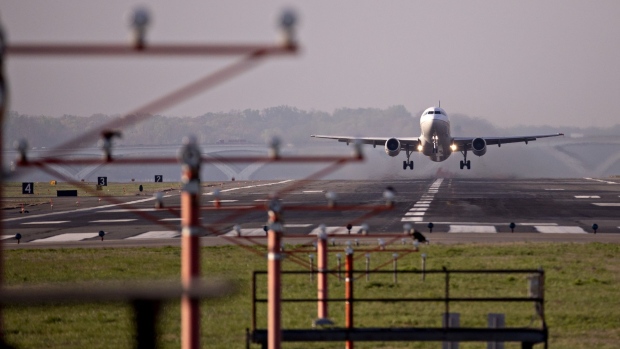Apr 8, 2020
U.S. airlines to cut summer flights up to 90% with rebound hopes seeming remote
, Bloomberg News

U.S. airlines are starting to look past the coronavirus peak, anticipating a world where travelers remain leery about returning to the skies and flights are drastically reduced in the normally robust summer travel season.
The bleak picture is compounding an already dire financial situation for the airlines, which are burning through cash and talking to the Treasury Department about grants. Newly revised federal rules will let the companies cut some routes by as much as 90 per cent through September and eliminate others altogether to avoid flying nearly empty planes.
A carrier that served a city less than five times weekly would need to provide only one flight a week under final Transportation Department rules issued Tuesday on minimum domestic flying levels through Sept. 30. A company with more than 25 weekly flights would be able to scale back to only five. On some routes, the drop in service could be about 90 per cent.
The regulations open the door to major service reductions as airlines gird for a lean summer, when planes are usually jammed and the industry collects its largest profits. Underscoring the urgency of the cuts, the number of people flying in the U.S. dropped to below 100,000 on Tuesday, 95 per cent below the level a year ago.
Flight Cuts
With domestic flights less than 10 per cent full because of the COVID-19 outbreak, carriers are eating through as much as US$20 billion a month, according to a trade group. And airlines aren’t betting on a swift rebound as they negotiate with the Treasury over US$25 billion in cash assistance.
A Standard & Poor’s Index of the five largest U.S. carriers plunged 45 per cent from March 1 through Wednesday -- more than quadruple the 10 per cent drop seen in the S&P 500.
“The airline companies are hurting badly,” Transportation Secretary Elaine Chao told Philadelphia station KYW Newsradio last week. “But there are still people that need to get to, for example, New York to California. They can’t spend three days driving.”
The Transportation Department is trying to balance all-but-nonexistent demand amid the pandemic with maintaining a semblance of normality in airlines’ domestic operations. For example, airlines that have at least one daily flight five days a week to a city must still maintain a daily flight on five days.
Trade group Airlines for America declined to comment on summer flight schedules. But major carriers are already cutting back as passengers stay home. Around the same time as the Transportation Department’s announcement, Southwest Airlines Co. extended a 50 per cent reduction in daily flights, to about 2,000, through June 27.
Days earlier, United Airlines Holdings Inc. slashed its hub in Newark, New Jersey, to 15 daily flights effective April 5. That’s down from 400 in February, before the New York area was especially hard hit by the virus. American Airlines Group Inc. chopped its service 95 per cent to 13 daily flights at the three big New York-area airports -- Newark, LaGuardia and John F. Kennedy International -- until May 6.
Distancing Measures
Mostly empty planes are allowing airlines to impose social-distancing on board by spacing out passengers to reduce the risk of infection -- a practice that could help reassure people about the safety of flying, as long as vacant seats persist. Delta Air Lines Inc. joined its peers Wednesday in formalizing measures such as blocking middle seats and boarding only 10 customers at a time.
Even assuming service rebounds to a certain extent during the summer, the new U.S. regulations would allow airlines to fly significantly less if they so choose. American could operate only one of its nine previously scheduled daily flights from LaGuardia to Chicago, depending on demand. Similar math applies at United and Delta.
Under the new regulations, airlines can consolidate their service to one airport in a metro area. They can also seek permission to end service to a city, with the affected destination given notice and a chance to object before the agency rules on the request.
JetBlue Airways Corp. will temporarily consolidate service among airports in five metropolitan areas, including New York and Los Angeles. That means cutting daily departures in those locations to 70 from 492 between April 15 and June 10, the airline said Wednesday.
‘Grave Concern’
The government’s blessing of deep airline cuts worries some airports, particularly those in smaller places that already had less service than larger peers. T.F. Green airport, near Providence, Rhode Island, expressed “grave concern” to the government, a worry echoed in letters sent by airports near Akron-Canton, Ohio, and Newport News, Virginia.
Airports remain concerned “about the prospect of maintaining connectivity for smaller communities to the national aviation system now and into the future as the carriers bring capacity back post-COVID-19,” Brad Van Dam, a senior vice president at the American Association of Airport Executives, said by email.
Larger hubs will retain connections at some level. But the future of demand is far from clear, and high cancellation levels now reflect the lack of passengers.
On the busy route between LaGuardia and Chicago O’Hare airport, for example, four airlines had 22 scheduled nonstop flights on Tuesday with at least 16 of those canceled, according to data from tracking firm FlightAware.com.
Given the dramatic decline in traffic, many Southwest employees are curious whether the airline still needs to fly, Chief Executive Officer Gary Kelly said in a video message to employees this week.
“Our loads are light and it’s logical that I continue to get this question,” he said. “But the answer is, yes. People still need to fly, and we need to be there for those who still have to travel for essential work that’s happening.”




